西安电子科技大学:《纠错码》课程教学资源(课件讲义)Decoding BCH/RS Codes
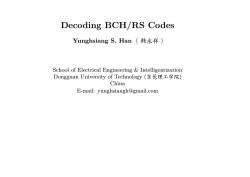
Decoding BCH/RS Codes Yunghsiang S.Han(韩永祥) School of Electrical Engineering Intelligentization Dongguan University of Technology(东莞理工学院) China E-mail:yunghsiangh@gmail.com
Decoding BCH/RS Codes Yunghsiang S. Han (韩永祥) School of Electrical Engineering & Intelligentization Dongguan University of Technology (东莞理工学院) China E-mail: yunghsiangh@gmail.com
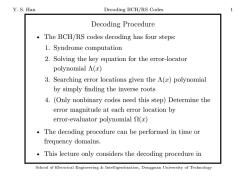
Y.S.Han Decoding BCH/RS Codes 1 Decoding Procedure The BCH/RS codes decoding has four steps: 1.Syndrome computation 2.Solving the key equation for the error-locator polynomial A(x) 3.Searching error locations given the A(x)polynomial by simply finding the inverse roots 4.(Only nonbinary codes need this step)Determine the error magnitude at each error location by error-evaluator polynomial (x) The decoding procedure can be performed in time or frequency domains. This lecture only considers the decoding procedure in School of Electrical Engineering Intelligentization,Dongguan University of Technology
Y. S. Han Decoding BCH/RS Codes 1 Decoding Procedure • The BCH/RS codes decoding has four steps: 1. Syndrome computation 2. Solving the key equation for the error-locator polynomial Λ(x) 3. Searching error locations given the Λ(x) polynomial by simply finding the inverse roots 4. (Only nonbinary codes need this step) Determine the error magnitude at each error location by error-evaluator polynomial Ω(x) • The decoding procedure can be performed in time or frequency domains. • This lecture only considers the decoding procedure in School of Electrical Engineering & Intelligentization, Dongguan University of Technology
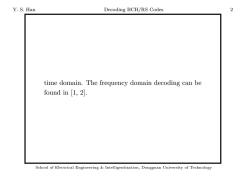
Y.S.Han Decoding BCH/RS Codes 2 time domain.The frequency domain decoding can be found in [1,2]. School of Electrical Engineering Intelligentization,Dongguan University of Technology
Y. S. Han Decoding BCH/RS Codes 2 time domain. The frequency domain decoding can be found in [1, 2]. School of Electrical Engineering & Intelligentization, Dongguan University of Technology
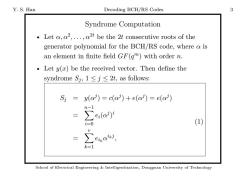
Y.S.Han Decoding BCH/RS Codes 3 Syndrome Computation .Let a,a2,.2 be the 2t consecutive roots of the generator polynomial for the BCH/RS code,where a is an element in finite field GF(g")with order n. Let y(z)be the received vector.Then define the syndrome Si,1≤j≤2t,as follows: Sj y(ai)=c(a)+e(ai)=e(ai) n-1 oy (1) U k=1 School of Electrical Engineering Intelligentization,Dongguan University of Technology
Y. S. Han Decoding BCH/RS Codes 3 Syndrome Computation • Let α, α2 , . . . , α2t be the 2t consecutive roots of the generator polynomial for the BCH/RS code, where α is an element in finite field GF(q m) with order n. • Let y(x) be the received vector. Then define the syndrome Sj , 1 ≤ j ≤ 2t, as follows: Sj = y(α j ) = c(α j ) + e(α j ) = e(α j ) = n ∑−1 i=0 ei (α j ) i = ∑ v k=1 eik α ikj , (1) School of Electrical Engineering & Intelligentization, Dongguan University of Technology
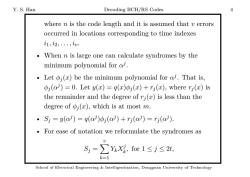
Y.S.Han Decoding BCH/RS Codes where n is the code length and it is assumed that v errors occurred in locations corresponding to time indexes i1,i2,…,iu When n is large one can calculate syndromes by the minimum polynomial for a. Let i(x)be the minimum polynomial for a.That is, j(a)=0.Let y(x)=q(x)oj(x)+rj(x),where ri(x)is the remainder and the degree of ri(z)is less than the degree of ()which is at most m. Sj=y(ai)=q(ai)oj(a)+rj(ai)=rj(aj). For ease of notation we reformulate the syndromes as ∑kX,ior1≤j≤2t, k- School of Electrical Engineering Intelligentization,Dongguan University of Technology
Y. S. Han Decoding BCH/RS Codes 4 where n is the code length and it is assumed that v errors occurred in locations corresponding to time indexes i 1, i2, . . . , iv. • When n is large one can calculate syndromes by the minimum polynomial for α j . • Let ϕj (x) be the minimum polynomial for α j . That is, ϕj (α j ) = 0. Let y(x) = q(x)ϕj (x) + rj (x), where rj (x) is the remainder and the degree of rj (x) is less than the degree of ϕj (x), which is at most m. • Sj = y(α j ) = q(α j )ϕj (α j ) + rj (α j ) = rj (α j ). • For ease of notation we reformulate the syndromes as Sj = ∑ v k=1 YkX j k , for 1 ≤ j ≤ 2t, School of Electrical Engineering & Intelligentization, Dongguan University of Technology
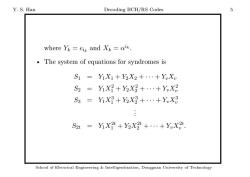
Y.S.Han Decoding BCH/RS Codes 5 where Y eig and Xk=aik. The system of equations for syndromes is S1=YX1+Y2X2+…+Y,X S2=X子+Y2X号+…+YX S3=YiX+Y2X+…+Y,X3 S2t=Yixi+Y2x2+..+Yox2t School of Electrical Engineering Intelligentization,Dongguan University of Technology
Y. S. Han Decoding BCH/RS Codes 5 where Yk = eik and Xk = α ik . • The system of equations for syndromes is S1 = Y1X1 + Y2X2 + · · · + YvXv S2 = Y1X2 1 + Y2X2 2 + · · · + YvX2 v S3 = Y1X3 1 + Y2X3 2 + · · · + YvX3 v . . . S2t = Y1X2t 1 + Y2X2t 2 + · · · + YvX2t v . School of Electrical Engineering & Intelligentization, Dongguan University of Technology
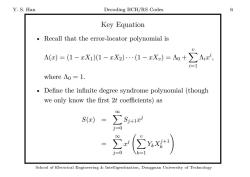
Y.S.Han Decoding BCH/RS Codes 6 Key Equation Recall that the error-locator polynomial is A()=(1-X1-xX2)…1-xX)=A0+∑Aa, where Ao=1. Define the infinite degree syndrome polynomial (though we only know the first 2t coefficients)as 0 S(x)= ∑S+1 j= j=0 k-1 School of Electrical Engineering Intelligentization,Dongguan University of Technology
Y. S. Han Decoding BCH/RS Codes 6 Key Equation • Recall that the error-locator polynomial is Λ(x) = (1 − xX1 )(1 − xX2 )· · ·(1 − xXv ) = Λ0 + ∑ v i=1 Λi x i , where Λ0 = 1. • Define the infinite degree syndrome polynomial (though we only know the first 2t coefficients) as S(x) = ∑ ∞ j=0 Sj+1x j = ∑ ∞ j=0 x j ( ∑ v k=1 YkX j+1 k ) School of Electrical Engineering & Intelligentization, Dongguan University of Technology
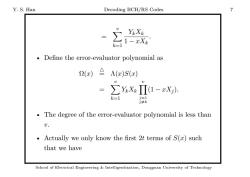
Y.S.Han Decoding BCH/RS Codes YhXk 1-xXk k=1 Define the error-evaluator polynomial as 2(x))AA()S() ∑KXkΠ1-xX) k= The degree of the error-evaluator polynomial is less than U. Actually we only know the first 2t terms of S(x)such that we have School of Electrical Engineering Intelligentization,Dongguan University of Technology
Y. S. Han Decoding BCH/RS Codes 7 = ∑ v k=1 YkXk 1 − xXk . • Define the error-evaluator polynomial as Ω(x) △ = Λ(x)S(x) = ∑ v k=1 YkXk ∏ v j=1 j̸=k (1 − xXj ). • The degree of the error-evaluator polynomial is less than v. • Actually we only know the first 2t terms of S(x) such that we have School of Electrical Engineering & Intelligentization, Dongguan University of Technology
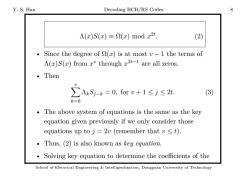
Y.S.Han Decoding BCH/RS Codes 8 A(x)S(x)=2(x)mod x24. (2) Since the degree of (x)is at most v-1 the terms of A()S(a)from through a2-1 are all zeros. 。Then ∑AkS)-k=0,foru+1≤j≤2t. (3) k=0 The above system of equations is the same as the key equation given previously if we only consider those equations up to j=2v(remember that v<t). Thus,(2)is also known as key equation. Solving key equation to determine the coefficients of the School of Electrical Engineering Intelligentization,Dongguan University of Technology
Y. S. Han Decoding BCH/RS Codes 8 Λ(x)S(x) ≡ Ω(x) mod x 2t . (2) • Since the degree of Ω(x) is at most v − 1 the terms of Λ(x)S(x) from x v through x 2t−1 are all zeros. • Then ∑ v k=0 Λk Sj−k = 0, for v + 1 ≤ j ≤ 2t. (3) • The above system of equations is the same as the key equation given previously if we only consider those equations up to j = 2v (remember that v ≤ t). • Thus, (2) is also known as key equation. • Solving key equation to determine the coefficients of the School of Electrical Engineering & Intelligentization, Dongguan University of Technology
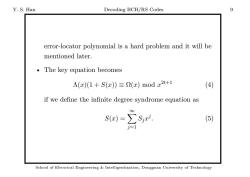
Y.S.Han Decoding BCH/RS Codes 9 error-locator polynomial is a hard problem and it will be mentioned later. The key equation becomes A()(1+S(2))=2(2)mod 224+1 (4) if we define the infinite degree syndrome equation as (5) j=1 School of Electrical Engineering Intelligentization,Dongguan University of Technology
Y. S. Han Decoding BCH/RS Codes 9 error-locator polynomial is a hard problem and it will be mentioned later. • The key equation becomes Λ(x)(1 + S(x)) ≡ Ω(x) mod x 2t+1 (4) if we define the infinite degree syndrome equation as S(x) = ∑ ∞ j=1 Sj x j . (5) School of Electrical Engineering & Intelligentization, Dongguan University of Technology
按次数下载不扣除下载券;
注册用户24小时内重复下载只扣除一次;
顺序:VIP每日次数-->可用次数-->下载券;
- 西安电子科技大学:《纠错码》课程教学资源(课件讲义)BCH Codes.pdf
- 西安电子科技大学:《纠错码》课程教学资源(课件讲义)Introduction to Finite Fields.pdf
- 西安电子科技大学:《信息论与编码理论基础》课程PPT教学课件(信息论)第九章 率失真函数.ppt
- 西安电子科技大学:《信息论与编码理论基础》课程PPT教学课件(编码部分)卷积码.pptx
- 西安电子科技大学:《信息论与编码理论基础》课程PPT教学课件(编码部分)循环码.pptx
- 西安电子科技大学:《信息论与编码理论基础》课程PPT教学课件(编码部分)有限域.ppt
- 西安电子科技大学:《信息论与编码理论基础》课程PPT教学课件(编码部分)线性分组码.pptx
- 西安电子科技大学:《信息论与编码理论基础》课程PPT教学课件(编码部分)码纠错能力的判断.ppt
- 西安电子科技大学:《信息论与编码理论基础》课程PPT教学课件(信息论)第五章 信道编码定理.ppt
- 西安电子科技大学:《信息论与编码理论基础》课程PPT教学课件(信息论)第四章 信道及其容量.ppt
- 西安电子科技大学:《信息论与编码理论基础》课程PPT教学课件(信息论)第三章 信源编码(一)离散信源无失真编码.ppt
- 西安电子科技大学:《信息论与编码理论基础》课程PPT教学课件(信息论)第二章 信息量和熵.ppt
- 西安电子科技大学:《信息论与编码理论基础》课程PPT教学课件(信息论)第一章 引论(主讲:孙蓉).ppt
- 西安电子科技大学:《纠错码与差错控制》课程教学资源(PPT课件)第四章 多项式环与有限域.ppt
- 西安电子科技大学:《纠错码与差错控制》课程教学资源(PPT课件)第三章 线性分组码.ppt
- 西安电子科技大学:《纠错码与差错控制》课程教学资源(PPT课件)第二部分 代数引论.ppt
- 西安电子科技大学:《纠错码与差错控制》课程教学资源(PPT课件)第一章 纠错码基本概念(主讲:孙蓉).ppt
- 安徽科技学院:《电子技术》课程教学资源(PPT课件)第二章 基本放大电路.ppt
- 安徽科技学院:《电子技术》课程教学资源(PPT课件)第三章 集成运算放大器.ppt
- 广东海洋大学:电子工程系《毕业论文(设计)》指导书.pdf
- 西安电子科技大学:《纠错码》课程教学资源(课件讲义)Cyclic Codes.pdf
- 西安电子科技大学:《纠错码》课程教学资源(课件讲义)Introduction to Binary Linear Block Codes(主讲:韩永祥).pdf
- 西安电子科技大学:《纠错码》课程教学资源(课件讲义)Introduction to Reed-Solomon Codes[.pdf
- 西安电子科技大学:《通信原理》课程教学资源(课件讲稿)第1章 绪论(主讲:刘龙伟).pdf
- 西安电子科技大学:《通信原理》课程教学资源(课件讲稿)第2章 随机过程.pdf
- 西安电子科技大学:《通信原理》课程教学资源(课件讲稿)第3章 信道与噪声.pdf
- 西安电子科技大学:《通信原理》课程教学资源(课件讲稿)第4章 模拟通信系统.pdf
- 西安电子科技大学:《通信原理》课程教学资源(课件讲稿)第5章 数字基带传输系统.pdf
- 西安电子科技大学:《通信原理》课程教学资源(课件讲稿)第6章 模拟信号的数字传输(1/3)6.1 抽样定理 超链接 6.2 脉冲幅度调制(PAM)超链接.pdf
- 西安电子科技大学:《通信原理》课程教学资源(课件讲稿)第6章 模拟信号的数字传输(2/3)6.3 脉冲编码调制(PCM).pdf
- 西安电子科技大学:《通信原理》课程教学资源(课件讲稿)第6章 模拟信号的数字传输(3/3)6.4 自适应差分脉冲编码调制 6.5 增量调制(△M)6.6 时分复用(TDM).pdf
- 西安电子科技大学:《通信原理》课程教学资源(课件讲稿)第7章 数字频带传输系统.pdf
- 西安电子科技大学:《通信原理》课程教学资源(课件讲稿)第10章 复用和数字复接技术.pdf
- 西安电子科技大学:《通信原理》课程教学资源(课件讲稿)第11章 同步技术.pdf
- 西安电子科技大学:《通信原理》课程教学资源(课件讲稿)第8章 数字信号的最佳接收.pdf
- 西安电子科技大学:《通信原理》课程教学资源(课件讲稿)第9章 现代数字调制解调技术.pdf
- 西安电子科技大学:《通信原理》课程教学资源(辅导资料)ISI.ppt
- 西安电子科技大学:《通信原理》课程教学资源(辅导资料)Viterbi译码.ppt
- 《通信原理》课程教学资源(辅导资料)Selected MIMO Techniques and their Performance.pdf
- 西安电子科技大学:《信号检测与估值》课程教学资源(课件讲稿,2019)第一章 高斯信道上的信号检测.pdf
